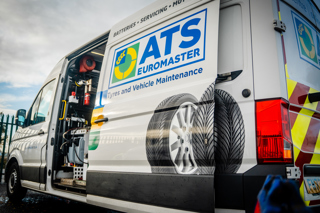Service, maintenance and repair (SMR) is one of the key areas for a fleet as they strive to minimise costs and vehicle downtime.
Routine maintenance, servicing and repair of vehicles will ensure they perform to their best and spend more time on the road: maximising the asset, keeping costs to a minimum and ensuring a fleet is as safe and efficient as possible.
This means adopting the most appropriate SMR option is imperative for an organisation.
For many, a fully-maintained SMR contract from a fleet management or leasing company has been the traditional choice for both cars and light commercial vehicles.
Last year’s FN50 research of the UK’s largest contract hire companies found 62% of cars and 59% of vans are supplied with full-maintenance agreements.
These see a fleet charged a regular amount per month per vehicle to cover all routine SMR costs, regardless whether they are ever required.
Typically, tyres, breakdown cover and wear and tear items are provided on a no-quibble policy basis, while the payments also include a level of built-in contingency for any additional ad hoc work.
This arrangement continues until the end of the contract life of the vehicle.
With maintenance packages simplify budgeting and operational procedures as they offer a no-risk package at a set price.
They also remove the need to administer this process in-house.
However, critics claim they also offer less transparency and potentially higher costs if strong management controls mean a fleet requires minimal SMR.
Pay-as-you-go maintenance
Many fleet decision-makers also assert that switching to a pay-as-you-go (PAYG) model gives them greater control, improved cashflow and more transparency and visibility over what they are paying for.
With PAYG, a fleet only pays for what it needs, potentially saving thousands of pounds.
The reliability of new vehicles has led to extended warranties and longer service intervals, making workshop appointments something of a rarity for anything other than tyre replacements during an average three-year or 70,000-mile lease.
This trend is becoming all the more pronounced requirements with the reduced maintenance of electric vehicles.
As fleets will have a detailed insight of all spend, they will be able to monitor any trends – for example excess tyre wear – to gain an insight on driver behaviour.
However, successfully managing PAYG requires robust processes and engaged drivers to ensure maintenance and repair costs don’t start to creep up, and to minimise the chances of the unforeseen major expense.
The question for fleet decision-makers is whether this can be done in-house – with the potential for a dramatically increased administrative burden – or whether it makes more sense to outsource it.
Many organisations appointing a fleet management specialist to look after the PAYG maintenance to capitalise on the potential savings – they are also able to leverage the buying power of a dedicated SMR partner network – as well as reduce admin.
If this option is chosen, it is imperative that large fleets operating nationally work with SMR providers with the right geographical spread.
Specialist fleet management providers should also be able to advise what the expected running costs of specific makes and models of vehicles should be if driven in an optimal manner, enabling effective benchmarking to be carried out.
Electric vehicle SMR
An often-mentioned potential advantage of battery electric vehicles (BEVs) compared to petrol or diesel counterparts is the lower SMR costs, due largely to their comparative lack of moving parts, minimising the likelihood of downtime and reducing less routine maintenance.
For BEVs, Fleet Assist’s average cost of SMR jobs on its network was £171 in 2022, 40% lower than all other vehicle types including ICE and hybrid (£243) compared to the previous year.
But the average ago if ICE vehicles analysed last year was three-and-a-half years older than the equivalent BEV, which was likely due to the ICE vehicles being retained by fleets due to extended contracts and vehicle availability.
This combination would result in larger jobs and major components being fitted to ICE vehicles so has to be taken into consideration.
Rivus has reported overall SMR costs for fully electric LCVs are 20% lower than for ICE equivalents, while the service costs are 65% lower.
The company has measured the costs by comparing BEVs seen by its service network with ICE vehicles which are from the same model line-up and registered at the same time.
One SMR area BEVs are expected to suffer in comparison to ICE alternatives is tyre costs because their extra weight and high instant torque would lead to higher wear.
This has been supported by data from Rivus, which has found tyre costs are 15% greater for a fully-electric van than its ICE counterpart, but wider evidence is inconclusive.
If electric cars were fitted with the same tyres as ordinary vehicles, the rates of wear would be great, but they are not.
Electric car tryes are built to withstand the pressure of the increased battery weight and manufacturer improved not only the rubber compound and sidewall strength, but also the tread and groove design for resilience.
As a result, they are more expensive than regular tyres, but due to their strain-absorbing structure, they will wear down less quickly.”
Tyres for electric company cars are on average both bigger and more expensive than those for petrol or diesel equivalents.
Epyx found the average replacement tyre fitted to an EV is 18.59 inches and costs £207 while, for ICE cars, the corresponding figures are 17.40 inches and £130.
Tyre management
Tyres are a critical piece of equipment for all vehicles – they are the only part which is in contact with the road – and such is their impact on legal compliance, safety and efficiency, fleets should have a specific tyre management policy.
T Determining the optimum time to replace tyres can have significant cost, safety and compliance implications for fleets.
Although the current minimum tread depth is 1.6mm, many fleets have policies that tyres will be replaced at 2mm for safety and compliance reasons.
This means fleets replace tyres more frequently that they legally have to, increasing downtime while new tyres are fitted, as well as the extra cost.
However, it is generally accepted that the lower the tread depth, the worse a tyre’s wet weather performance.
Kwik Fit research has found that in the wet at 70mph, the stopping distance of a car fitted with new tyres – 8mm of tread – is calculated to be almost 100m. With 3mm this increases to 150m and with 1.6m it is 200m – double that of a vehicle fitted with a new tyre.
Tyre procurement
The different ways in which fleets buy their tyres can have a great impact on vehicle downtime.
Therefore, fleet decision-makers should take this into account when considering their procurement method.
When vehicles are leased with the tyre maintenance included then a leasing company is likely to have a preferred deal with a service provider, usually one of the high street retail chains.
If this preferred fast-fit is not located close to an employee’s workplace or home – and they have to travel a significant difference to reach one – then there will inevitably be downtime.
However, if the supplier offers mobile fitting services, then new tyres can generally be fitted at a location of the driver’s choice.
Companies which offer mobile fitting can often provide on-site checks, highlighting any issues before they become a serious problem.
Fleet decision-makers have the right to choose where tyres are sourced from, although the leasing company is likely to specify the terms and conditions of having the vehicle back with the same brand of tyres and tread depth.
If vehicles do not have a service agreement in place – and it is possible to have service agreements which exclude tyres – and tyres are bought by the fleet, there could an opportunity to reduce downtime by utilising a local fast-fit or mobile tyre fitting service.
Booking ahead
An ever-increasing number of tyre brands, sizes and types mean drivers should not turn up at a fitting centre unannounced, expecting their particular tyre to be in stock.
In 1997, 19 tyre sizes accounted for up to 90% of company car tyre fitments, but today this proportion is accounted for by more than 120 tyre sizes.
Taking into account the choice of standard, winter and all-season tyres and the option of premium, mid-range and budget brands across a wide range of sizes, it is possible that a customer’s preferred choice of tyre may not be in stock.
As a direct consequence, drivers risk making wasted journeys and increasing tyre-related downtime unless they plan ahead and book an appointment.
Tyre labelling scheme
The tyre labelling scheme can be a useful tool for fleet managers comparing tyres for wet grip (reflecting stopping distance), fuel efficiency (based on the tyre’s rolling resistance to the road) and noise performance (rated in decibels; a single sound wave is the best rating).
It was introduced under the European Tyre Labelling regulation, with tyres rated from A to G.
Continental says a vehicle fitted with a set of A-graded tyres could potentially provide a fuel saving of about 7.5mpg over one fitted with G-rated tyres. A-grade tyres also deliver a 30% improvement in braking distance compared to G-rated ones.
While fleet decision-makers can use this scheme to decide what tyres to fit, it is also important they focus on identifying the demands their vehicles face, and what policy would offer them the lowest whole-life costs.
Winter or cold weather tyres?
One way fleets can help to reduce the risk of vehicles being off the road through collisions in the colder, wetter months is to use either dedicated winter tyres or the new generations of all season tyres.
These provide greater traction in difficult conditions – typically in conditions that are less than 7C - than standard tyres.
Many fast-fits offer a ‘tyre hotel’ service which allows fleets to store their standard tyres when the winter ones are in use, but this policy creates its own downtime when tyres are switched over, as well as extra cost.
In-life tyre management
Research from Michelin has found that more than 50% of car run on tyres which are below recommended pressures.
When tyres are under- or over-inflated, the tread area in contact with the road is reduced: over-inflated tyres will make more contact with the road in the centre, while under-inflation will make more contact with the outer edges.
Both are bad news as they cause irregular wear, while traction will also be reduced, meaning tyres are less effective at gripping the road surface and bringing the car to a halt: factors which mean tyres may need replacing more often, as well as increasing the possibility of a collision.
Tyres should also be regularly checked for any wear and damage such as bulges in sidewalls.
Early detection of any issue can reduce the risk of unnecessary vehicle downtime.
For many van fleets, the vehicle check – including tyres – is a daily requirement for drivers, with some refusing to assign employees their first job of the day until the check has been completed.























Login to comment
Comments
No comments have been made yet.